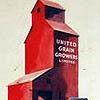Home | Living With War | Communities Go To War | The Economic Front | Agriculture
Agriculture
 Canada was an important supplier of food and food products to the Allied war effort. Prior to and during the Second World War, farmers in western Canada produced very high quantities of wheat—to the detriment of other grains. The government passed the Wheat Board Amendment Act in 1940 to encourage farmers, by way of financial incentives, to switch from wheat to other coarse grains: oats and barley. These were needed for livestock feed.
Canada was an important supplier of food and food products to the Allied war effort. Prior to and during the Second World War, farmers in western Canada produced very high quantities of wheat—to the detriment of other grains. The government passed the Wheat Board Amendment Act in 1940 to encourage farmers, by way of financial incentives, to switch from wheat to other coarse grains: oats and barley. These were needed for livestock feed.
Increases in livestock production were needed to ensure that troops had sufficient amounts of meat (protein), notably pork (bacon and ham). Beef production increased, but not to the same degree; raising cattle was a capital intensive proposition. Poultry and sugar beet production also increased. Dried (powdered) eggs were required in large quantities to feed the troops, and the ban on sugar imports resulted in an increase in domestic sugar beet production.
The agricultural sector was particularly hard hit by wartime labour shortages. At the onset of the war, many farmers enlisted or left for the cities to work in various war industries. Having struggled for more than a decade simply to survive, many farmers were eager for steady work and a regular paycheque.
Women and children helped to fill the void—at least in part. More than ever, farmers helped each other out during planting and harvest seasons and, although difficult to acquire, new equipment and technologies also helped alleviate some of the pressures caused by the labour shortages. When extra labourers were needed for planting and harvesting, urban industries released employees to work on nearby farms, and older students were granted leave from school to help out.
To help alleviate the situation among southern Alberta’s sugar beet producers, Japanese internees (from British Columbia) and German Prisoners of War from camps in Lethbridge and Medicine Hat were assigned to farms. The government deferred military training for new recruits from farm families so they could remain on the land and, in 1942, policymakers passed legislation prohibiting agricultural workers from leaving their jobs.
References
Boas, William S. Canada in World War II: Post-War Possibilities. Montreal: William Boas & Co., 1945.
MacPherson, Ian and Thompson, John Herd. “An Orderly Reconstruction: Prairie Agriculture in World War Two.” Canadian Papers in Rural History, Vol. 4, ed. Donald H. Akenson. Gananoque, Ontario: Langdale Press, 1984.








